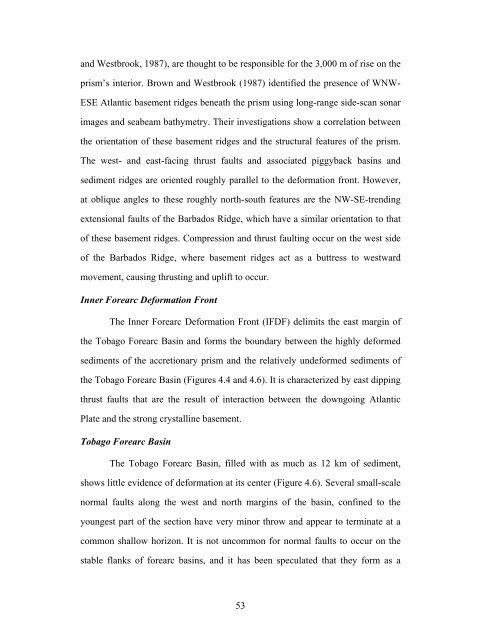Copyright by Nysha Chaderton 2009 - The University of Texas at ...
Copyright by Nysha Chaderton 2009 - The University of Texas at ...
Copyright by Nysha Chaderton 2009 - The University of Texas at ...
You also want an ePaper? Increase the reach of your titles
YUMPU automatically turns print PDFs into web optimized ePapers that Google loves.
and Westbrook, 1987), are thought to be responsible for the 3,000 m <strong>of</strong> rise on the<br />
prism’s interior. Brown and Westbrook (1987) identified the presence <strong>of</strong> WNW-<br />
ESE Atlantic basement ridges bene<strong>at</strong>h the prism using long-range side-scan sonar<br />
images and seabeam b<strong>at</strong>hymetry. <strong>The</strong>ir investig<strong>at</strong>ions show a correl<strong>at</strong>ion between<br />
the orient<strong>at</strong>ion <strong>of</strong> these basement ridges and the structural fe<strong>at</strong>ures <strong>of</strong> the prism.<br />
<strong>The</strong> west- and east-facing thrust faults and associ<strong>at</strong>ed piggyback basins and<br />
sediment ridges are oriented roughly parallel to the deform<strong>at</strong>ion front. However,<br />
<strong>at</strong> oblique angles to these roughly north-south fe<strong>at</strong>ures are the NW-SE-trending<br />
extensional faults <strong>of</strong> the Barbados Ridge, which have a similar orient<strong>at</strong>ion to th<strong>at</strong><br />
<strong>of</strong> these basement ridges. Compression and thrust faulting occur on the west side<br />
<strong>of</strong> the Barbados Ridge, where basement ridges act as a buttress to westward<br />
movement, causing thrusting and uplift to occur.<br />
Inner Forearc Deform<strong>at</strong>ion Front<br />
<strong>The</strong> Inner Forearc Deform<strong>at</strong>ion Front (IFDF) delimits the east margin <strong>of</strong><br />
the Tobago Forearc Basin and forms the boundary between the highly deformed<br />
sediments <strong>of</strong> the accretionary prism and the rel<strong>at</strong>ively undeformed sediments <strong>of</strong><br />
the Tobago Forearc Basin (Figures 4.4 and 4.6). It is characterized <strong>by</strong> east dipping<br />
thrust faults th<strong>at</strong> are the result <strong>of</strong> interaction between the downgoing Atlantic<br />
Pl<strong>at</strong>e and the strong crystalline basement.<br />
Tobago Forearc Basin<br />
<strong>The</strong> Tobago Forearc Basin, filled with as much as 12 km <strong>of</strong> sediment,<br />
shows little evidence <strong>of</strong> deform<strong>at</strong>ion <strong>at</strong> its center (Figure 4.6). Several small-scale<br />
normal faults along the west and north margins <strong>of</strong> the basin, confined to the<br />
youngest part <strong>of</strong> the section have very minor throw and appear to termin<strong>at</strong>e <strong>at</strong> a<br />
common shallow horizon. It is not uncommon for normal faults to occur on the<br />
stable flanks <strong>of</strong> forearc basins, and it has been specul<strong>at</strong>ed th<strong>at</strong> they form as a<br />
53
















